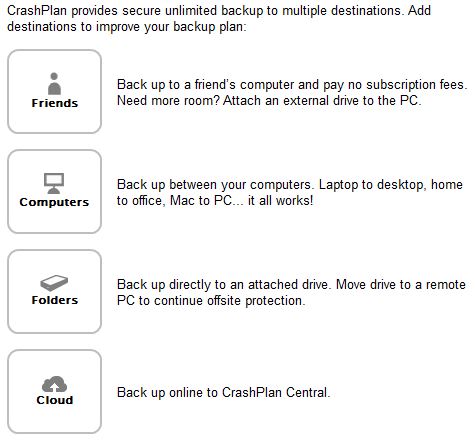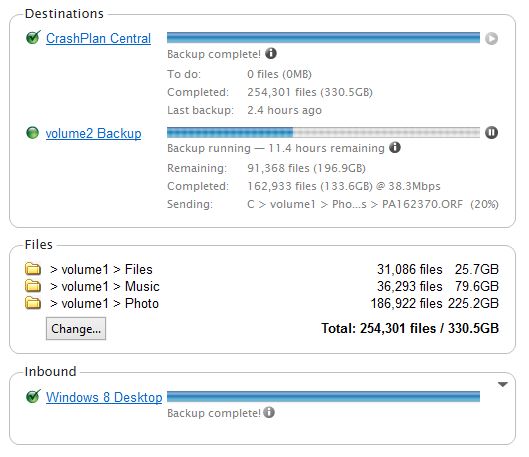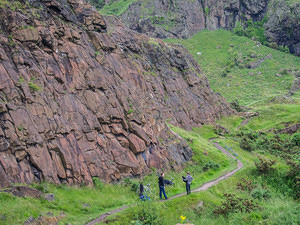I’ve got a lot of data. I’ve been been shooting RAW photos for a decade (almost 200 GB at this point), have a large (legit!) music collection (74 GB), and have a lot of other files from various projects over the years I want to hang onto. In total, I’ve got about 330 GB I want to keep. This used to be a very expensive proposition – stuffing it all in Amazon S3 or using backup services that charge by file size was tough to swallow. That landscape has changed recently. I’ve been using CrashPlan+ Family Unlimited for my home backups for about a year and couldn’t be happier. Unlimited cloud backups for up to 10 computers for $9-14 per month (depending on subscription length) is an amazing deal.
More than being a good deal I’ve also been very impressed with the CrashPlan software as well. It does the typical things you want to see in backup software – good performance, ability to set transfer rates/time of day, data deduplication, compression, and encryption. However it’s hidden strength is its great flexibility for backup targets while maintaining security. In addition to the unlimited cloud storage you can also have local encrypted backups, encrypted backups to another one of your computers running CrashPlan (p2p using the same account), or even send your encrypted backups to a friend (p2p with different CrashPlan accounts). These options create a perfect backup scenario for me – I know I have a local copy of files which I can get at quickly (compared with downloading them all) but they are also stored in the cloud to protect against catastrophic loss (e.g. a house fire).

Their software is available for multiple platforms, and they support a headless java client on Linux. This means the software can be installed on a lot of different machine types and opens up a lot of different options. The most important one for me is support in Synology. I’ve been using Synology NASs as my file server for many years as they are very customizable and powerful. With some hard work invested, patters was able to get the headless client running on a wide range of newer Synology devices. Using his packages and instructions I’ve got all of the files on my Synology file server backing up locally, as well as to the cloud:
Desktop/laptops
- Backup to local Synology NAS Crashplan target (Vol2)
- Backup to Crashplan cloud
Synology NAS (Vol1)
- Backup Vol1 to local Synology NAS Crashplan target (Vol2)
- Backup to Crashplan cloud
Some screen shots of what this looks like:


If you find the post at pcloadletter.co.uk hard to follow, Scott Hanselman has a great guide on his site on how to setup CrashPlan on Synology.
Other than having to restart the Synology CrashPlan package after updates, everything has worked amazingly well together. I was able to customize everything the way I needed to but still feel like I’m well protected. If you aren’t using a backup solution you like, I highly recommend giving CrashPlan a try – the following link will save you 20% off their prices: http://www.crashplan.com/ff20






